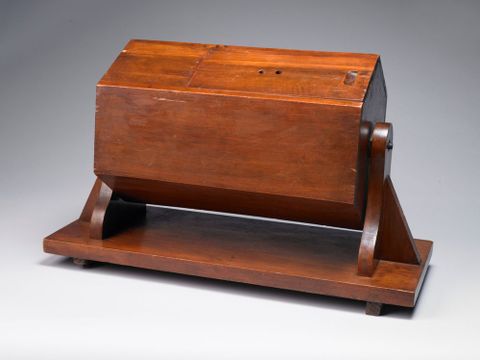
On 16 November 1916, two rotating wooden barrels spun into action for the first time, playing a key role over the next two years in the conscription ballot (compulsory enlistment in the armed forces) of almost 140,000 Pakeha men for the New Zealand Expeditionary Force.
One of the two barrels (above) has survived the century and is in Te Papa’s history collection, currently on display in Slice of Heaven: 20th Century Aotearoa.
The barrel is tangible evidence of what one newspaper of the day called a ‘gamble in human life’ in an ‘epoch making event in New Zealand’s history’.
The two ballot barrels were put into service because, by 1916, supplies of volunteers to fight on the Western Front were beginning to dry up.
After two years of fighting it became more likely that men would have to be conscripted to meet demand.
The Military Services Act, which came into force on 1 August 1916, created the legal and bureaucratic framework for conscription. In November, after the quota for the 23rd and 24th Reinforcements fell short by 1300, it was implemented for the first time.
The men whose names went into the ballot were part of the ‘Expeditionary Force Reserve’ and were known as reservists (see poster above). The reserve was based on a military census that had been taken in 1915, of men all living in New Zealand between the ages of 17 and 60.
Initially, only the names of unmarried reservists (and those who had married after 1 May 1915) would go into the ballot. But eventually, after this so-called ‘First Division’ was exhausted, conscription would be applied firstly to childless married men and then to those with children.
Malcolm Fraser, the government statistician, devised a convoluted but impartial balloting process that used two barrels to randomly select conscripts.
There were 94 marbles in one barrel. The order in which these came out determined the order in which 94 alphabetically arranged drawers were pulled from file cabinets. The order in which 500 marbles were drawn from another barrel determined the order in which reservists’ registration cards were pulled from these drawers.
On the day of the first ballot, dread of the unknown frayed the nerves of many New Zealanders. The Oamaru Mail wrote that the moment was, for many homes, ‘fraught with serious, even terrible, possibilities’.
 Alexander Turnbull Library, Wellington." width="450" height="322" />
Alexander Turnbull Library, Wellington." width="450" height="322" />
And, as David Cossgrove, the Director of Recruiting (also Chief Commander of the Boy Scouts – see above) later put it:
‘For the first time in the history of the English speaking people of the world the single men of military age of a British community found themselves subject to a lottery, the prize of which might be anything from Home Service in New Zealand to death on the battle-field’.
Security for the ballot was tight and public interest was high. The government statistician and a magistrate plus two other male observers were present in the room, along with members of the press and a cameraman.
Those who held the fate of the men in their hands appeared to be anxious: one official fumbled nervously and dropped a drawn marble, sending two others scrambling to retrieve it from the floor.
However, and surprisingly, just the one marble appears to have been dropped during the marathon effort it took to draw enough names for the two drafts.
The names of these conscripts were published in newspapers and the Government Gazette.
Some would fail their medical examinations while others would appeal their call-up; a handful would skip the country.
But a fair number had their fates sealed: they were destined to march into camp for training before departing in March and April 1917 on the troopships Ruapehu, Corinthic, Devon and Pakeha (above), with the badges of 23rd and 24th Reinforcements (below) on their lemon squeezers.